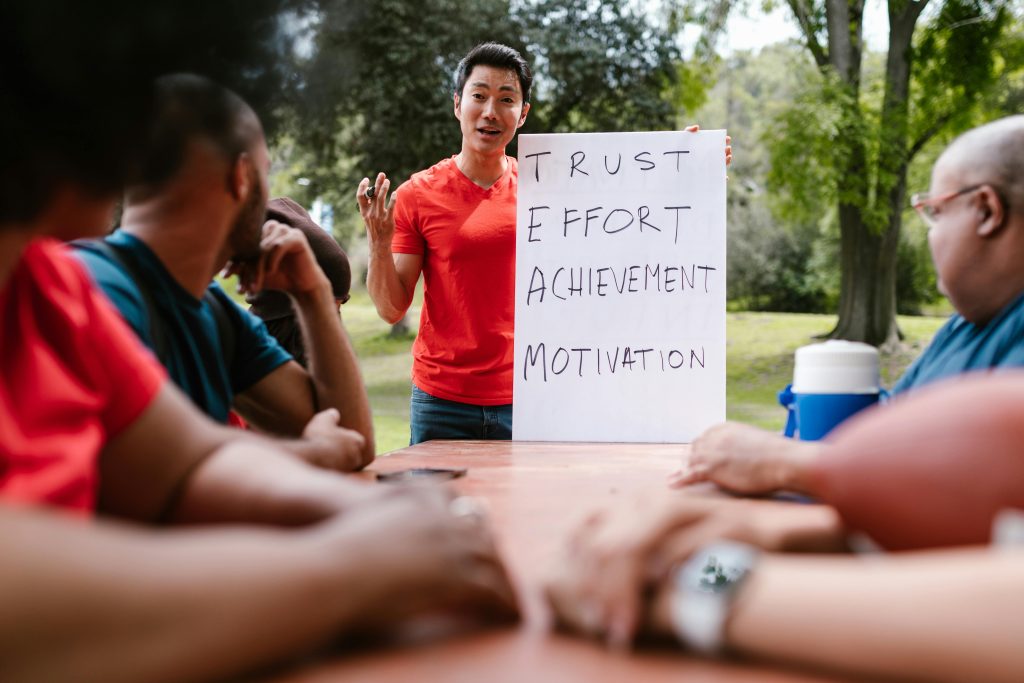Leadership isn’t a badge you wear or a title you hold—it’s what you do. It’s how you show up for your team, tackle problems head-on, and inspire others to give their best in the most challenging situations. Green Berets learn these lessons not from a classroom but in the field, leading some of the most capable and demanding teams on the planet.
This post is the first in a series where I’ll break down what leadership really takes. We’ll start at 30,000 feet, giving you the big-picture view, and future posts will dig into specifics like trust-building, time management, and strategic planning. Whether you’re leading a startup, a boardroom, or your own small team, these lessons will help you unleash your full leadership potential.
Leading Lions: The Real Challenge of Leadership
Here’s the hard truth: leadership and management are not the same thing. You manage systems, budgets, and schedules—but people? You lead them. And that means earning their trust, understanding what drives them, and aligning their strengths to achieve a common purpose.
Leading a team of Green Beret is like trying to herd lions. You’ve heard about herding cats right? What if every one of those cats was bigger, badder, faster, smarter, more talented, and better looking than you! That’s what it’s like to build and lead a team where everyone is capable, independent, and highly skilled – people that, anywhere else, would be in charge. These aren’t people who blindly follow orders—they’re the kind who will challenge your decisions and call you out if they think you’re wrong. Sound like your team? If so, you know how tough it can be to harness all that energy and talent without stifling it.
Leadership in this context isn’t about control; it’s about alignment. It’s creating an environment where these “lions” can thrive—where they trust you enough to follow and trust each other enough to collaborate.
Trust: The Bedrock of Leadership
If there’s one thing you take away from this book, let it be this: trust is the foundation of everything. I’m not talking about “normal” trust – the kind of thing where you trust that someone won’t steal your lunch from the refrigerator if it has your name on it. That’s passive. Great teams that achieve the impossible are built on what I call Fierce or Active Trust. That’s the kind of trust your people have when they say that they don’t really understand yet what your new thing is all about – but they’ll follow you into the gates of hell. Real trust isn’t passive; it requires intention and effort. It is forged through the deliberate practice of the 4 C’s:
- Character: It’s all about integrity. It really doesn’t matter what your ethics or personal values are as long as you’ve made them public and apply them every time without fail – and especially practice it yourself. It must be authentic or, very soon, the team will realize you’ve tried to fool them – and you’ll never, ever regain that trust. This is the core of trust—your team must believe in your integrity and commitment to shared values.
- Communication: Everyone says that good communication is important, but no one seems to know what it really is. Real communication is actually generosity of spirit and involves a combination of Consideration and your character. It is about going beyond transactional interactions to share knowledge selflessly and empower others as well as sharing information even when you don’t have time or don’t want to.
- Consideration: True CONSIDERATION goes beyond “servant” or ”empathetic” leadership; it’s more than just exhibiting kindness, courtesy, and respect. It’s genuinely caring about your team and understanding what motivates each of them to properly align their goals with yours and the company’s.
- Coaching is instrumental in developing both the individual and the team as a whole. It’s a fundamental aspect of leadership that goes beyond mere instruction—it’s about nurturing potential and fostering a culture of continuous growth in a spirit of humility and fearlessness.
Without trust, nothing else works. Your team can spot insincerity from a mile away. They’ll know if you’re all talk and no action. However, when you build and foster Active Trust, it becomes a force multiplier. It unlocks open communication, deep collaboration, and an unshakable willingness to go the extra mile, especially when the stakes are high.
Trust isn’t static; it requires daily investment. As leaders, we build trust by embodying these principles consistently in every interaction, proving through our actions that we’re worthy of the confidence our team places in us.
Purpose: Your Team’s Guiding Light
Special Operations teams don’t operate without a mission. Purpose is what drives us, especially when things get tough. But purpose isn’t just for the battlefield—it’s for every team, everywhere. Your people need to understand not only what they’re doing but why it matters. Because discipline as part of the daily slog will only get you so far – discipline dies without purpose.
As a leader, it’s your job to articulate that purpose clearly and tie it back to the individual motivations of your team members. If someone can see how their contribution directly impacts the team’s success, they’re far more likely to give their best effort. Purpose aligns actions, drives accountability, and keeps everyone focused, even when the path gets rocky.
EPIC Leadership: A Framework for Modern Leaders
EPIC Leadership—Empathy, Purpose, Innovation, and Culture—is the blueprint for leading high-performing teams in complex, ever-changing environments. It’s MUCH more than “servant” or simple Empathetic leadership. No one follows a servant anywhere – unless they are escorting you to your hotel room. And just being empathetic might make someone nice to work for, but without a mission focus, a “leader” doesn’t have a job. The EPIC model empowers leaders to inspire action and drive results with intention.
- Empathy: Understanding your team’s needs and perspectives isn’t optional—it’s essential. Empathy fosters trust and collaboration, the foundation of any successful mission. Empathetic Communication is a required skill.
- Purpose serves as the cornerstone of effective leadership; it’s the”why” behind every task. It gives meaning to actions and decisions and aligns the team’s efforts towards a common goal,
- Inspiration: Motivate and elevate your team by modeling resilience and passion, empowering them to achieve beyond expectations.
- Character: Integrity and authenticity are non-negotiable. EPIC leaders are defined by their unwavering commitment to a set of values and behaviors, ensuring their actions consistently inspire trust and respect.
EPIC Leadership is more than a framework—it’s a mindset for leaders who want to inspire, adapt, and achieve. By embracing these principles, you’ll create a team dynamic capable of overcoming obstacles and accomplishing the extraordinary.
We’ll dive deeper into EPIC Leadership in the next post, but for now, think of it as your roadmap to leading with intention and impact.
The Art of Planning and Execution
A big part of leadership is knowing how to plan and execute effectively. In Special Forces, we rely on the Green Beret Mission Planning Process (GBMP), which is built on the idea that no plan survives first contact with reality. But that doesn’t mean planning is useless—it’s essential.
There’s a reason that the most successful design companies in the world use this process. It give you the power to fully utilize the diverse talents of everyone on your team and still keep the process on track and on time. It is the secret to making the best decisions every time.
Building Culture: Ethosynthesis in Action
There’s this idea that leadership and culture are separate things – nothing could be further from the truth. In every organization the culture of trust and accountability doesn’t emerge spontaneously. It is deliberately shaped through Ethosynthesis, a leader’s actions that establish the values, attitudes, and behaviors permeating the team. Leaders are not just participants in the culture—they are its architects.
A leader’s actions, decisions, and behaviors set the tone for what is acceptable and expected within the team. Leaders who embody the organization’s core values and ethics foster a culture of integrity, where actions align with values. Small daily interactions at the team level can significantly affect long-term cultural elements at the company level. How leaders and employees embody these core values in their daily actions (ethos) shapes the authenticity of the company’s culture.
Bad cultures make for disengaged employees, and according to studies by the Queens School of Business and Gallup, disengaged workers had:
- 37% higher absenteeism
- 49% more accidents
- 60% more errors and defects
- 18% lower productivity
And therefore the companies those people work for had:
- 16% lower profitability
- 37% lower job growth
- 65% lower share price over time
You can find numerous articles from reliable sources about the power of a good culture. But the evidence is overwhelming that creating a good culture has real benefits; so let’s build one, shall we?
Adapting to Win: The Power of Resilience
The best leaders aren’t the ones with all the answers—they’re the ones who know how to adapt. Special Forces missions are dynamic, and the ability to pivot when things change is critical. As a leader, you need to cultivate resilience—not just in yourself, but in your team. That means creating an environment where failure is seen as a learning opportunity and where people feel supported, even when they stumble.
The Leadership Journey Starts Here
This is just the beginning. Over the course of this series, we’ll dive into the tools and frameworks that make great leadership possible. We’ll talk about building trust, mastering time management, and creating a team culture that lasts. We’ll break down the EPIC framework and show you how to apply it in your organization. And we’ll explore the skills and principles that set great leaders apart from the rest of us.
Stay tuned—because we’re just getting started.




